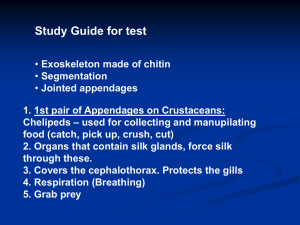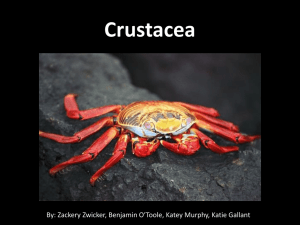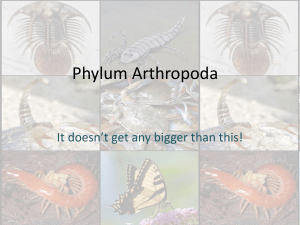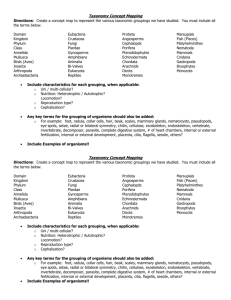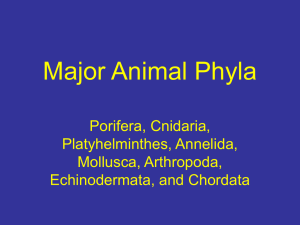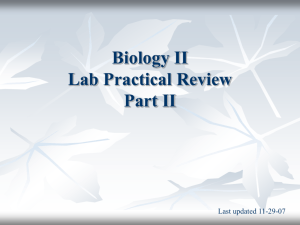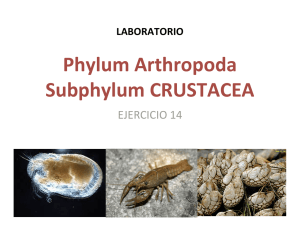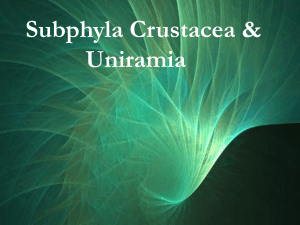Case 3467 Seifried, 2003 (Crustacea, Copepoda, Harpacticoida): proposed emendation of spelling to
advertisement
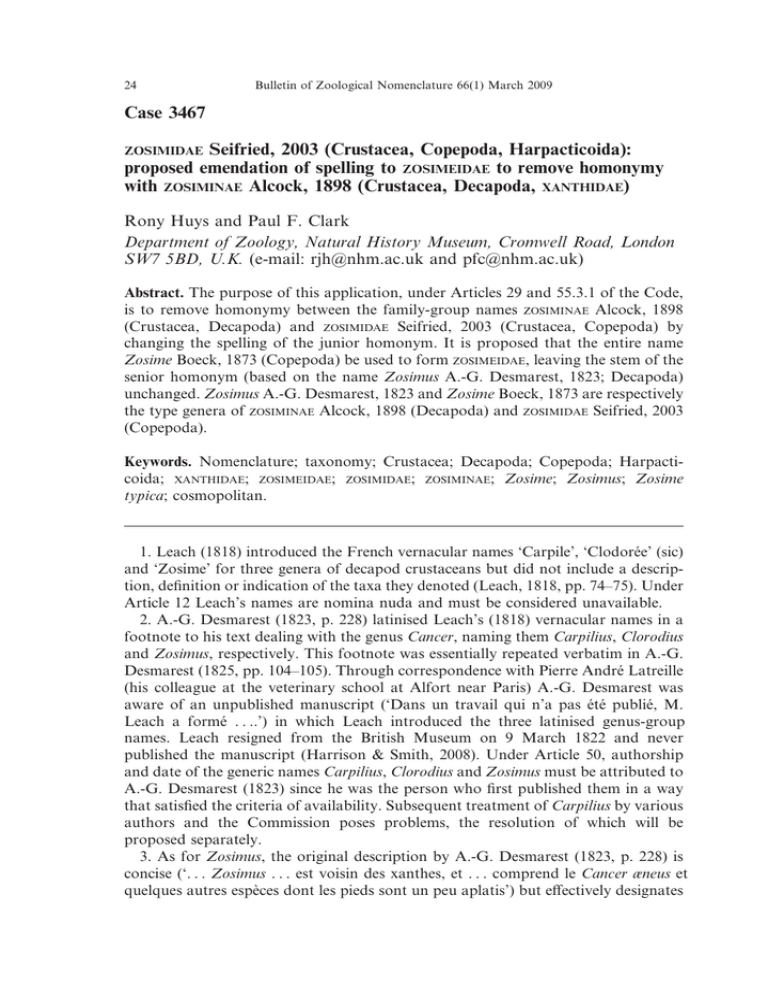
24 Bulletin of Zoological Nomenclature 66(1) March 2009 Case 3467 ZOSIMIDAE Seifried, 2003 (Crustacea, Copepoda, Harpacticoida): proposed emendation of spelling to ZOSIMEIDAE to remove homonymy with ZOSIMINAE Alcock, 1898 (Crustacea, Decapoda, XANTHIDAE) Rony Huys and Paul F. Clark Department of Zoology, Natural History Museum, Cromwell Road, London SW7 5BD, U.K. (e-mail: rjh@nhm.ac.uk and pfc@nhm.ac.uk) Abstract. The purpose of this application, under Articles 29 and 55.3.1 of the Code, is to remove homonymy between the family-group names ZOSIMINAE Alcock, 1898 (Crustacea, Decapoda) and ZOSIMIDAE Seifried, 2003 (Crustacea, Copepoda) by changing the spelling of the junior homonym. It is proposed that the entire name Zosime Boeck, 1873 (Copepoda) be used to form ZOSIMEIDAE, leaving the stem of the senior homonym (based on the name Zosimus A.-G. Desmarest, 1823; Decapoda) unchanged. Zosimus A.-G. Desmarest, 1823 and Zosime Boeck, 1873 are respectively the type genera of ZOSIMINAE Alcock, 1898 (Decapoda) and ZOSIMIDAE Seifried, 2003 (Copepoda). Keywords. Nomenclature; taxonomy; Crustacea; Decapoda; Copepoda; Harpacticoida; XANTHIDAE; ZOSIMEIDAE; ZOSIMIDAE; ZOSIMINAE; Zosime; Zosimus; Zosime typica; cosmopolitan. 1. Leach (1818) introduced the French vernacular names ‘Carpile’, ‘Clodorée’ (sic) and ‘Zosime’ for three genera of decapod crustaceans but did not include a description, definition or indication of the taxa they denoted (Leach, 1818, pp. 74–75). Under Article 12 Leach’s names are nomina nuda and must be considered unavailable. 2. A.-G. Desmarest (1823, p. 228) latinised Leach’s (1818) vernacular names in a footnote to his text dealing with the genus Cancer, naming them Carpilius, Clorodius and Zosimus, respectively. This footnote was essentially repeated verbatim in A.-G. Desmarest (1825, pp. 104–105). Through correspondence with Pierre André Latreille (his colleague at the veterinary school at Alfort near Paris) A.-G. Desmarest was aware of an unpublished manuscript (‘Dans un travail qui n’a pas été publié, M. Leach a formé . . ..’) in which Leach introduced the three latinised genus-group names. Leach resigned from the British Museum on 9 March 1822 and never published the manuscript (Harrison & Smith, 2008). Under Article 50, authorship and date of the generic names Carpilius, Clorodius and Zosimus must be attributed to A.-G. Desmarest (1823) since he was the person who first published them in a way that satisfied the criteria of availability. Subsequent treatment of Carpilius by various authors and the Commission poses problems, the resolution of which will be proposed separately. 3. As for Zosimus, the original description by A.-G. Desmarest (1823, p. 228) is concise (‘. . . Zosimus . . . est voisin des xanthes, et . . . comprend le Cancer æneus et quelques autres espèces dont les pieds sont un peu aplatis’) but effectively designates Bulletin of Zoological Nomenclature 66(1) March 2009 25 Cancer aeneus Linnaeus, 1758 as the type species by monotypy. E. Desmarest’s (1858, p. 17) subsequent designation of ‘Cancer rugosus Fabr.’ as type species of ‘Zozymus’ is not only invalid but also refers to an incorrect binominal name and authorship. The French vernacular name (Zozyme ridé) cited by E. Desmarest (1858) suggests that he meant the species described as Zozymus rugatus H. Milne Edwards, 1834 (p. 385) (and denoted by the same vernacular name) now placed in the genus Liomera Dana, 1851. 4. Despite the history recounted above, the generic name Zosimus was placed on the Official List of Generic Names in Zoology in Opinion 85 (16 December 1925) and attributed to ‘Leach in Desmarest, 1823’ (Smithsonian Miscellaneous Collections, 73(3): 13–18). Later, in Direction 37 (Completion of the entries relating to names of certain genera of the Order Decapoda (Class Crustacea) placed on the Official List of Generic Names in Zoology in the period up to the end of 1936; 1 September 1956), the name Zosimus was attributed to either ‘Leach, 1823’ (pp. 53, 69) or ‘Leach, 1825’ (pp. 61, 77) without reference to A.-G. Desmarest at all (Opinions and Declarations 1(Section D, Part D.2): 47–82). 5. The nomenclatural history of the genus Zosimus is riddled with subsequent incorrect spellings, which in many cases led to the erroneous citation of family-group names based on them. As was noted above, Henri Milne Edwards (1834, p. 383) used the spelling Zozymus for Zosimus, referring to it in a footnote as ‘Zozymus Leach’. This subsequent spelling was adopted by many authors (e.g. Miers, 1886, p. 134; Henderson, 1893, p. 359; Alcock, 1898, p. 103; Balss, 1922, p. 124; Sakai, 1939, p. 450; Ward, 1942, p. 85; Tweedie, 1950, p. 115). The Commission (Direction 37, 1 September 1956) ruled that Zozymus Milne Edwards (H.) was an incorrect subsequent spelling for Zosimus Leach, 1825 (Opinions and Declarations 1(Section D, Part D.2): 47–82), but the name nevertheless continued to be in wide usage (e.g. Sankarankutty, 1961, p. 128; Edmondson, 1962, p. 225; Chang, 1963, p. 98; Michel, 1964, p. 32; Kensley, 1981, p. 46). Other incorrect subsequent spellings of Zosimus include Zozimus by Boone (1934, p. 99), Zoozymus by Balss (1938, p. 38) and Zosymus by Serène (1968, p. 73), which was subsequently adopted by Sakai (1976, pp. 402–403). 6. Alcock (1898, p. 77) subdivided the subfamily XANTHINAE into six ‘Alliances’, which would nowadays be attributed infrasubfamilial rank similar to that of tribe. In the ZOZYMOIDA (based on the incorrect subsequent spelling Zozymus) he included the genera Atergatis de Haan, 1833, Lophactaea A. Milne Edwards, 1862, Zozymus Leach in Desmarest, 1823 and Lophozozymus A. Milne Edwards, 1863 (Alcock, 1898, p. 94). The next reference to this family-group name is Stimpson’s (1907, p. 57) posthumous publication (prepared in 1858), which makes mention of a taxon ZOZYMINAE. Both Serène (1968, p. 73) and Sakai (1976, pp. 385, 401) continued to use ZOZYMOIDA while Takeda (1976, p. 70) followed Stimpson (1907) in attributing subfamilial rank to the taxon (as ZOZYMINAE). Family-group names based on incorrect subsequent spellings are to be corrected (Article 32.5.3.3 of the Code). Serène (1984, p. 137) corrected the spelling to ZOSIMINAE in accordance with the original spelling of the type genus and placed the subfamily in the XANTHIDAE, but erroneously attributed authorship to ‘Stimpson, 1907’. Števčić (2005, p. 44) effectively cited ZOSIMINI Alcock, 1898 as one of nine tribes recognised within the subfamily XANTHINAE and listed Zosimus (attributed to Leach, 1818) as the type genus. In recent years, authors (e.g. Clark & Ng, 1998; Clark et al., 2004; Poore, 26 Bulletin of Zoological Nomenclature 66(1) March 2009 2004) have treated the taxon as a subfamily ZOZIMINAE in the XANTHIDAE and this rank is also used in Ng et al. (2008, pp. 30, 205). 7. Boeck (1873, p. 45) introduced the generic name Zosime for a new genus of harpacticoid copepods in a publication completely lacking in illustrations. The only originally included species was Zosime typica Boeck, 1873, which is the type species by monotypy. A detailed re-description was provided by Sars (1903, pp. 27–28, Plate XV) based on material from the type locality (Oslofjord). Members of Zosime are common representatives of the harpacticoid communities in deepwater benthic habitats (e.g. Fiers, 1991; Huys et al., 1992; Ahnert & Schriever, 2001; Baguley et al., 2006) and several authorities have published species identification keys for the genus (Bodin, 1968; Coull, 1973; Dinet, 1974). According to Wells (2007, p. 73) Zosime currently accommodates 14 valid species and two subspecies, but it is known that several new species await description (e.g. Carey & Montagna, 1982; Kotwicki, 2002; Mu et al., 2002; Seifried, 2003). 8. Sars (1903, p. 26) placed the genus Zosime Boeck, 1873 in the family CERVINIIDAE Sars, 1903 (a junior synonym of AEGISTHIDAE Giesbrecht, 1893) but this assignment was disputed by Lang (1944, p. 10; 1948, p. 361), who transferred the genus to a new subfamily IDYANTHINAE Lang, 1944 in the family TISBIDAE Stebbing, 1910. Por (1967, p. 123) attributed Zosime Boeck, 1873 to the family TACHIDIIDAE Boeck, 1865 but this placement is almost certainly a lapsus calami. The family-group name ZOSIMIDAE was first introduced as an nomen nudum by Huys et al. (1992, Table 2 & p. 37) in an ecological paper. Although the taxa ‘ZOSIMIDAE (Zosime, Tachidiella)’ and ‘IDYANTHIDAE (Idyella, Idyanthe, Tachidiopsis)’ were treated as separate entities in Huys et al.’s (1992) analysis, under Article 13.1 of the Code, the nomenclatural impact of this act is nil. Seifried (2003, p. 100) established a new family ZOSIMIDAE for the genera Zosime Boeck, 1873, Peresime Dinet, 1974 and Pseudozosime T. Scott, 1912, which she had removed from the former tisbid subfamily IDYANTHINAE. 9. ZOSIMIDAE Seifried, 2003 (type genus Zosime Boeck, 1873) (Copepoda) is a junior homonym of ZOSIMINAE Alcock, 1898 (type genus Zosimus A.-G. Desmarest, 1823 (Decapoda). Under Article 55.3.1 the homonymy between ZOSIMINAE Alcock, 1898 and ZOSIMIDAE Seifried, 2003 must be referred to the Commission. We propose that the entire generic name Zosime Boeck, 1873 be adopted as the grammatical stem, so that the copepod family name will become ZOSIMEIDAE and the homonymy will be removed. 10. The International Commission on Zoological Nomenclature is accordingly asked: (1) to use its plenary power to rule that for the purposes of Article 29 of the Code the stem of the generic name Zosime Boeck, 1873 is Zosime-; (2) to place on the Official List of Generic Names in Zoology the name Zosime Boeck, 1873 (gender: feminine), type species by monotypy Zosime typica Boeck, 1873 (Crustacea, Copepoda); (3) to place on the Official List of Specific Names in Zoology the name typica Boeck, 1873 as published in the binomen Zosime typica (specific name of the type species of Zosime Boeck, 1873) (Crustacea, Copepoda); (4) to place on the Official List of Family-Group Names in Zoology the following names: (a) ZOSIMINAE Alcock, 1898, type genus Zosimus A.-G. Desmarest, 1823 (Crustacea, Decapoda); Bulletin of Zoological Nomenclature 66(1) March 2009 27 (b) ZOSIMEIDAE Seifried, 2003, type genus Zosime Boeck, 1873 (spelling emended by the ruling in (1) above) (Crustacea, Copepoda); (5) to place on the Official Index of Rejected and Invalid Family-Group Names in Zoology the name ZOSIMIDAE Seifried, 2003 (an incorrect original spelling of ZOSIMEIDAE, as ruled in (1) above) (Crustacea, Copepoda). Acknowledgements We thank Dr Keith Harrison (Harrogate, U.K.) and the late Professor Lipke B. Holthuis (Naturalis, Leiden) for their help and comments on this case. References Ahnert, A. & Schriever, G. 2001. Response of abyssal Copepoda Harpacticoida (Crustacea) and other meiobenthos to an artificial disturbance and its bearing on future mining for polymetallic nodules. Deep-Sea Research Part II: Topical Studies in Oceanography, 48(17): 3779–3794. Alcock, A. 1898. Materials for a Carcinological Fauna of India. No 3. The Brachyura Cyclometopa. Part I. The family Xanthidae. Journal of the Asiatic Society of Bengal, 67(2)(1): 67–233. Baguley, J.G., Montagna, P.A., Lee, W, Hyde, L.J. & Rowe, G.T. 2006. Spatial and bathymetric trends in Harpacticoida (Copepoda) community structure in the Northern Gulf of Mexico deep-sea. Journal of Experimental Marine Biology and Ecology, 330: 327–341. Balss, H. 1922. Ostasiatische Dekapoden. IV. Die Brachyrhynchen (Cancridea). Archiv für Naturgeschichte, 88A(11): 94–166. Balss, H. 1938. Die Dekapoden Brachyura von Dr. Sixten Bocks Pazifik-Expedition 1917–1918. Göteborgs Kungl. Vetenskaps- och Vitterhets-Samhälles Handlingar, serien B (Matematiska och Naturvetenskapliga Skrifter), 5(7): 1–85. Bodin, P. 1968. Copépodes Harpacticoïdes des étages bathyal et abyssal du golfe de Gascogne. Mémoires du Muséum National d’Histoire Naturelle, Paris, Nouvelle série, (A)55(1): 1–107. Boeck, A. 1865. Oversigt over de ved Norges Kyster jagttagne Copepoder henhörende til Calanidernes, Cyclopidernes og Harpactidernes Familier. Forhandlinger i Videnskabsselskabet i Kristiania, 1864: 226–282. Boeck, A. 1873. Nye Slaegter og Arter af Saltvands-Copepoder. Forhandlinger i Videnskabsselskabet i Kristiania, 1872: 35–60. Boone, L. 1934. Scientific results of the world cruise of the yacht ‘Alva’, 1931, William K. Vanderbilt, commanding. Crustacea: Stomatopoda and Brachyura. Bulletin of the Vanderbilt Marine Museum, 5: 1–210. Carey, A.G., Jr. & Montagna, P.A. 1982. Arctic sea ice faunal assemblage: first approach to description and source of underice meiofauna. Marine Ecology Progress Series, 8(1): 1–8. Chang, C. 1963. A check-list of Taiwan crabs with descriptions of 19 new records. Tunghai Journal, 5(2): 95–118. Clark, P.F. & Ng, P.K.L. 1998. The larval development of the poisonous mosaic crab, Lophozozymus pictor (Fabricius, 1798) (Crustacea, Decapoda, Brachyura, Xanthidae, Zosiminae), with comments on familial characters for first stage zoeas. Zoosystema, 20(2): 210–220. Clark, P.F., Ng, P.K.L. & Ho, P.-H. 2004. Atergatis subdentatus (De Haan, 1835), Atergatopsis germaini (A. Milne Edwards, 1865) and Platypodia eydouxi (A. Milne Edwards, 1865) (Crustacea: Decapoda: Xanthoidea: Xanthidae: Zosiminae)—first stage zoeal descriptions with implications for the subfamily. Raffles Bulletin of Zoology, 52(2): 563–592. Coull, B.C. 1973. Meiobenthic Harpacticoida (Crustacea, Copepoda) from the deep sea off North Carolina. III. The families Tisbidae Stebbing emend. Lang, Thalestridae Sars emend. Lang, and Diosaccidae Sars. Transactions of the American Microscopical Society, 92(4): 592–603. Dana, J.D. 1851. 1. On the classification of the Cancroidea. Scientific Intelligence, III. Zoology. The American Journal of Science and Arts, (2)12(34): 121–131. Desmarest, A.-G. 1823. Malacostracés, Malacostraca. (Crust.). Pp. 138–425 in Cuvier, F.G. (Ed.), Dictionnaire des sciences naturelles, dans lequel on traite méthodiquement des 28 Bulletin of Zoological Nomenclature 66(1) March 2009 différents êtres de la nature, considérés soit en eux-mêmes, d’après l’état actuel de nos connaissances, soit relativement à l’utilité qu’en peuvent retirer la médicine, l’agriculture, le commerce et les arts, vol. 28 [MAD-MANA]. 492 pp. F.G. Levrault & Le Normant, Strasbourg & Paris. Desmarest, A.-G. 1825. Considérations générales sur la classe des Crustacés, et description des espèces de ces animaux, qui vivent dans la mer, sur les côtes, ou dans les eaux douces de la France. xix, 446 pp. F.G. Levrault, Strasbourg. Desmarest, E. 1858. Crustacés. Pp. 1–70 in Chenu, J.C. (Ed.), Crustacés-MollusquesZoophytes. Encyclopédie d’Histoire naturelle ou traité complet de cette science d’après les travaux des naturalistes les plus éminents de tous les pays et de toutes les époques Buffon, Daubenton, Lacépède, G. Cuvier, F. Cuvier, Geoffroy Saint-Hilaire, Latreille, de Jussieu, Brogniart, etc., etc. 312 pp. Marescq et Cie, Gustave Havard, Paris. Dinet, A. 1974. Espèces nouvelles de Copépodes Harpacticoïdes (Crustacea) des sédiments profonds de la dorsale de Walvis. Archives de Zoologie Expérimentale et Générale, 115(4): 549–577. Edmondson, C.H. 1962. Xanthidae of Hawaii. Occasional Papers of the Bernice Pauahi Bishop Museum, 22(13): 215–309. Fiers, F. 1991. Three new harpacticoid copepods from the Santa Maria Basin off the Californian Pacific coast (Copepoda, Harpacticoida). Beaufortia, 42(2): 13–47. Giesbrecht, W. 1893. Systematik und Faunistik der pelagischen Copepoden des Golfes von Neapel und der angrenzenden Meeres-Abschnitte. Fauna und Flora des Golfes von Neapel und der angrenzenden Meeres-Abschnitte, Monographie, 19: 1–831, pls. 1–54. Haan, W. de. 1833. Crustacea. Pp. ix–xvi, 1–24, pls. 1–8, A, B, circ. 2 in Siebold, P.F. von (Ed.), Fauna Japonica, sive Descriptio animalium, quae in itinere per Japoniam, jussu et auspiciis superiorum, qui summum in India Batava imperium tenent, suscepto, annis 1823–1830 collegit, notis, observationibus et adumbrationibus illustravit. i–xvii, i–xxxi, ix–xvi, 1–244, plates A–J, L–Q, 1–55, circ. tab. 2. Lugduni-Batavorum (Leiden). Harrison, K. & Smith, E. 2008. Rifle-Green by Nature: A Regency Naturalist and his Family, William Elford Leach, vol. 171. 621 pp. Ray Society, London. Henderson, J.R. 1893. A contribution to Indian carcinology. Transactions of the Linnean Society of London, (2)5: 325–458. Huys, R., Herman, P.M.J., Heip, C.H.R. & Soetaert, K. 1992. The meiobenthos of the North Sea: density, biomass trends and distribution of copepod communities. ICES Journal of marine Science, 49: 23–44. Kensley, B. 1981. On the zoogeography of Southern African decapod Crustacea, with a distributional checklist of the species. Smithsonian Contributions to Zoology, 338: 1–64. Kotwicki, L. 2002. Benthic Harpacticoida (Crustacea, Copepoda) from the Svalbard archipelago. Polish Polar Research, 23(1): 185–191. Lang, K. 1944. Monographie der Harpacticiden (Vorläufige Mitteilung). 39 pp. Almqvist & Wiksells Boktryckeri Ab, Uppsala. Lang, K. 1948. Monographie der Harpacticiden. Vol. I: 1–896, figs. 1–361; Vol. II: 897–1682, figs. 362–607, maps 1–378. Håkan Ohlsson, Lund. Leach, W.E. 1818. Crustacés, Crustacea. Pp. 69–75 in Cuvier F.G. (Ed.), Dictionnaire des sciences naturelles, dans lequel on traite méthodiquement des différents êtres de la nature, considérés soit en eux-mêmes, d’après l’état actuel de nos connaissances, soit relativement à l’utilité qu’en peuvent retirer la médicine, l’agriculture, le commerce et les arts, vol. 12 [CRIT-DAZ]. 564 pp. F.G. Levrault & Le Normant, Strasbourg & Paris. Linnaeus, C. 1758. Systema Naturae, Ed. 10, vol. 1. 824 pp. Salvii, Holmiae. Michel, C. 1964. Check list of the Crustacea Brachyura (crabs) recorded from Mauritius. Bulletin of the Mauritius Institute, 6(1): 1–48. Miers, E.J. 1886. Part II.–Report on the Brachyura collected by H.M.S. Challenger during the years 1873–76. In Report on the Scientific Results of the Voyage of H.M.S. Challenger during the years 1873–1876 under the command of Captain George S. Nares, N.R., F.R.S. and the late Captain Frank Tourle Thomson, R.N. HMSO, London, Edinburgh & Dublin, 17: i–xl, 1–362, pls. 1–29. Bulletin of Zoological Nomenclature 66(1) March 2009 29 Milne Edwards, A. 1862. Monographie des Crustacés fossiles de la famille des Cancériens. VII. De l’agèle des Carpilides. Annales des Sciences Naturelles (Zoologie), (4)18: 42–85. Milne Edwards, A. 1863. Monographie des Crustacés fossiles de la famille des Cancériens. VIII. De l’agèle des Xanthides. Annales des Sciences Naturelles (Zoologie), (4)20: 273–324. Milne Edwards, H. 1834. Histoire naturelle des Crustacés, comprenant l’anatomie, la Physiologie et la Classification de ces animaux. xxxv, 468 pp. Librairie encyclopédique de Roret, Paris, vol. 1. Mu, F.-h., Somerfield, P.J., Warwick, R.M. & Zhang Z.N. 2002. Large-scale spatial patterns in the community structure of benthic harpacticoid copepods in the Bohai Sea, China. Raffles Bulletin of Zoology, 50(1): 17–26. Ng, P.K.L., Guinot, D. & Davie, P.J.F. 2008. Systema brachyurorum: Part I. An annotated checklist of extant brachyuran crabs of the world. Raffles Bulletin of Zoology, 17: 1–286. Poore, G.C.B. 2004. Marine Decapod Crustacea of Southern Australia. A Guide to Identification. 574 pp. CSIRO Publishing, Melbourne. Por, F.D. 1967. Level bottom Harpacticoida (Crustacea, Copepoda) from Elat (Red Sea), part I. – Israel Journal of Zoology, 16: 101–165. Sakai, T. 1939. Studies on the crabs of Japan. IV. Brachygnatha, Brachyrhyncha. Pp. 365–741. Yokendo, Tokyo. Sakai, T. 1976. Crabs of Japan and the adjacent seas. xxx, 773 pp., Kodansha Ltd, Tokyo. Sankarankutty, C. 1961. On some crabs (DeCapoda-Brachyura) from the Laccadive Archipelago. Journal of the Marine Biological Association of India, 3(1–2): 120–136. Sars, G.O. 1903. Copepoda Harpacticoida. Parts I & II, Misophriidae, Longipediidae, Cerviniidae, Ectinosomidae (part). An account of the Crustacea of Norway, with short descriptions and figures of all the species, 5: 1–28, pls. 1–16. Scott, T. 1912. The Entomostraca of the Scottish National Antarctic Expedition, 1902–1904. Transactions of the Royal Society of Edinburgh, 48: 521–599. Seifried, S. 2003. Phylogeny of Harpacticoida (Copepoda): revision of ‘Maxillipedasphalea’ and Exanechentera. 259 pp. Cuvillier Verlag, Göttingen. Serène, R. 1968. The Brachyura of the Indo-West Pacific region. Pp. 33–112 in: Prodromus for a Check List of the (non-planctonic) Marine Fauna of South East Asia. UNESCO, Singapore, Special Publication, no. 1, Fauna IIICc3. Serène, R. 1984. Crustacés Décapodes Brachyoures de l’Océan Indien Occidental et de la Mer Rouge, Xanthoidea: Xanthidae et Trapeziidae. Avec un addendum par Crosnier, A.: Carpiliidae et Menippidae. Faune Tropicale, 24: 1–400. Stebbing, T.R.R. 1910. General catalogue of South African Crustacea (part V of S.A. Crustacea, for the Marine Investigations in South Africa). Annals of the South African Museum, 6: 281–599. Števčić, Z. 2005. The reclassification of Brachyuran crabs (Crustacea: Decapoda: Brachyura). Natura Croatica (Periodicum Musei Historiae Naturalis Croatici), 14(suppl. 1): 1–159. Stimpson, W. 1907. Report on the Crustacea (Brachyura and Anomura) collected by the North Pacific Exploring Expedition, 1853–1856. Smithsonian Miscellaneous Collections, 49(1717): 1–240. Takeda, M. 1976. Studies on the Crustacea Brachyura of the Palau Islands, III. Xanthidae. Researches on Crustacea, Tokyo, 7: 69–99. Tweedie, M.W.F. 1950. The fauna of Cocos-Keeling Islands, Brachyura and Stomatopoda. Bulletin of the Raffles Museum, 22: 105–148. Ward, M. 1942. Notes on the Crustacea of the Dejardins Museum, Mauritius Institute, with descriptions of new genera and species. Bulletin of the Mauritius Institute, 2(2): 49–113. Wells, J.B.J. 2007. An annotated checklist and keys to the species of Copepoda Harpacticoida (Crustacea). Zootaxa, 1568: 1–872. Acknowledgement of receipt of this application was published in BZN 65: 161. Comments on this case are invited for publication (subject to editing) in the Bulletin; they should be sent to the Executive Secretary, I.C.Z.N., c/o Natural History Museum, Cromwell Road, London SW7 5BD, U.K. (e-mail: iczn@nhm.ac.uk).
